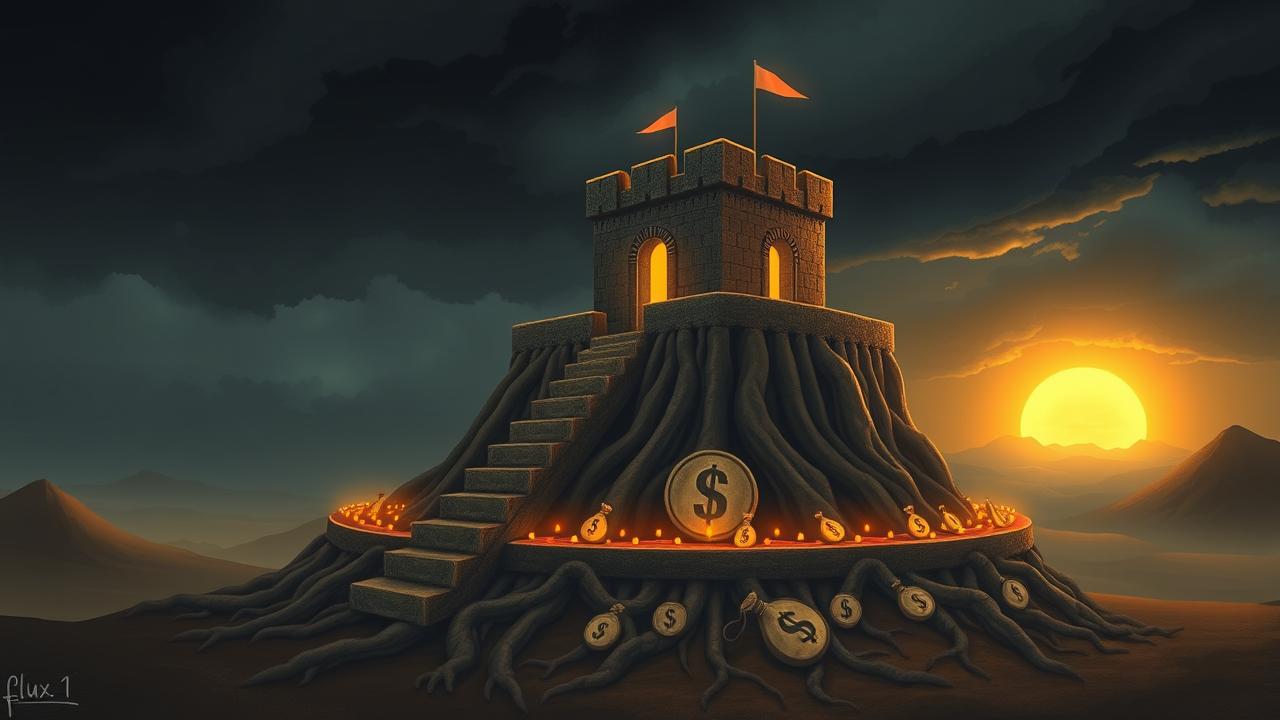The Weight of the Clock
There is a specific, metallic taste of dread that comes with a 5 a.m. alarm. It’s the flavor of a day you don’t own, a life rented out in hourly increments. You trade heartbeats for dollars, vitality for a paycheck that always seems to evaporate just before the next one arrives. This isn’t living; it’s a slow-motion trade. And deep down, in that quiet place where truth resides, you know there has to be another way.
This isn’t about getting rich quick. That’s a fool’s lottery ticket. This is about rewriting the contract between your time and your survival. It’s about building a machine—meticulously, piece by piece—that works for you, even when you’re sleeping, even when you’re sick, even when you’ve finally decided to just… stop. This is the raw, untamed power of a true passive income investment, and it’s the key to taking your life back.
The Escape Plan in Brief
Forget the noise. The core truth is simple: You either work for money, or you make money work for you. We’re dissecting the second path. We’ll unmask what passive income truly is (and what it isn’t), explore the gritty realities of real estate and dividend stocks through the eyes of people who’ve been in the trenches, and lay out a strategic map. This is about building systems that bleed cash into your account, freeing you from the tyranny of the timesheet and clawing back your most precious asset: your life.
The Grind vs. The Machine
That shrill alarm clock summons you to the grind. You show up, you perform tasks, you get paid. This is active income. It’s a direct transaction—your life-force for currency. Stop showing up, and the money stops. It feels secure, predictable, until the day it isn’t. Until the layoff, the illness, the moment you realize you’re a hamster on a wheel that someone else owns.
Passive income is the machine you build in the garage after the kids are asleep. It’s the seed you plant that grows into a tree bearing fruit year after year. It’s the asset that generates revenue with minimal ongoing labor. Oh, don’t be mistaken, it requires immense upfront work, capital, or both. The passive income vs active income debate isn’t about effort versus no effort; it’s about when and how that effort is applied. It’s about front-loading the pain for a lifetime of gain.
The Unvarnished Truth of Financial Autonomy
The air in the hyperbaric chamber was thick and tasted of recycled oxygen, a sterile echo of the crushing pressure waiting for him hundreds of feet below the waves. This was Myles’s office—a hostile, alien world where a single mistake meant oblivion. An underwater welder, he was paid handsomely for renting out his nerve and his anatomy to the abyss. But with every compression cycle, he felt his body breaking down, a biological clock ticking faster than the one on the wall. The money was good, but the cost was becoming unbearable.
What is a what is passive income investment? For Myles, it became a lifeline. It wasn’t some abstract financial term; it was the answer to a desperate question: How do I get out before the sea takes me for good? It’s the act of allocating capital—money you’ve bled for—into assets that generate their own momentum. It’s buying a piece of a company that shares its profits, owning a property that pays you rent, or funding a loan that yields interest. It is the strategic deployment of your past work to secure your future self.
A Glimpse of the Summit
It’s easy to look at the staggering numbers some people claim and dismiss it as fantasy. A guy making thousands per day while he sleeps? Sure. But look past the clickbait headline and listen to the mechanics. The video below unpacks seven different streams, some more “active” than others, but all built on the same principle: creating an asset once that pays you repeatedly. Absorb the systems, not just the dollar signs.
Video Source: Smart Money Bro
Your Arsenal of Assets
There is no single magic bullet. Anyone who tells you otherwise is selling something, probably a cheap course that promises the world and delivers a pamphlet. The most resilient financial fortresses are built with layers of defense. Your path to wealth requires a diversified approach, a blend of the best passive income investments tailored to your risk tolerance, capital, and a brutally honest assessment of how much work you’re willing to put in upfront.
Think of it like this: relying on one stream is like standing on a one-legged stool. It might hold you for a while, but it’s inherently unstable. A diversified portfolio combining stocks, real estate, and maybe even digital assets creates a stable platform. When one market shudders, the others can hold the line. This is the core of smart advanced investing and wealth building—it’s not about finding the one perfect investment, it’s about constructing a resilient ecosystem.
The Four Pillars of Income Generation
Drowning in options is just as bad as having none. To cut through the clutter, it helps to focus on the time-tested pillars that have consistently generated wealth. The following conversation zeroes in on four powerful investment types. It’s a deep dive, free of fluff, that explains the how and the why behind each one. Pay attention to the discussion on risk and return—it’s the heart of every investment decision you’ll ever make.
Video Source: Toby Mathis Esq on YouTube
The Scent of Damp Drywall and Broken Dreams
The brochure showed a smiling family on a manicured lawn. The reality for Theo, a commercial plumber by trade, was the sour smell of damp drywall and a tenant who paid rent in excuses. He had sunk his life savings and leveraged himself to the hilt to buy a duplex in a “promising” neighborhood. This was his big move, his break from trading his aching back for a paycheck. This was supposed to be the dream of real estate for passive income.
Instead, it was a second, unpaid job filled with midnight calls about a gurgling toilet or a flickering light. The “passive” part felt like a cruel joke whispered by the water heater he had to replace on a holiday weekend. He was a landlord, a handyman, a debt collector, and a therapist. The money that trickled in was almost immediately consumed by repairs and vacancies. This wasn’t an asset; it was a hungry ghost, haunting his bank account and his peace of mind. Theo learned the hard way that a property is only as passive as the systems you build around it—or the property manager you can afford to hire.
Owning the Empire, Not Fixing the Toilets
What if you could harness the power of real estate without getting a call about a raccoon in the attic? For investors haunted by stories like Theo’s, there’s another way. A Real Estate Investment Trust, or REIT, is a company that owns—and usually operates—income-producing real estate. We’re talking apartment complexes, sprawling shopping malls, data centers, and office towers.
By buying shares in a REIT, you become a fractional owner of a massive portfolio. You get the benefit of rental income and property appreciation, paid out as dividends, without the operational headaches. This is how you achieve passive income from reits. It offers the accessibility of the stock market with the tangible backing of brick and mortar. It’s Theo’s dream, but without the nightmares.
The Quiet Rebellion of Compound Growth
Jocelyn worked surrounded by silence and the faint, papery scent of decades-old records. As a medical archivist for a large hospital system, her days were meticulous, ordered, and profoundly quiet. But her internal world was a storm of financial anxiety, a constant hum of inadequacy fed by lifestyle inflation and the feeling of being perpetually behind. Her rebellion didn’t start with a bang, but with a whisper: a tiny, almost laughable investment into a dividend-paying ETF.
The first dividend payment was $4.17. It was nothing. A cup of coffee. But to Jocelyn, it was everything. It was money she hadn’t clocked in for. Money born from money. She reinvested it. Then she automated her contributions, siphoning off a small, painful amount from each paycheck. The journey of using dividend stocks for passive income wasn’t a rocket launch to wealth; it was a slow, stubborn march. Years later, those tiny streams had merged into a respectable tributary, a quiet but potent symbol of her financial independence that drowned out the hum of anxiety with the steady rhythm of growth.
Becoming the Bank
The traditional model is simple: you need a loan, you go to a bank. The bank uses its depositors’ money, lends it to you at a higher rate, and pockets the difference. Peer-to-peer (P2P) lending platforms blast that model to pieces. They are digital marketplaces that connect borrowers directly with investors.
You, the investor, become the bank. You can browse loan requests—for debt consolidation, a small business launch, a home renovation—and choose which ones to fund. Spreading your investment across dozens or even hundreds of small loans mitigates the risk of any single borrower defaulting. The interest payments from these borrowers become your return. This is the essence of generating passive income through peer-to-peer lending. It’s a beautifully simple concept, though one that demands careful due diligence. You are, after all, assessing the creditworthiness of strangers.
The New Frontier: Forging Wealth in the Digital Ether
The old titans of industry were built from steel and sweat. The new ones are built from code and content. Digital assets represent a paradigm shift in wealth creation. An e-book you write once can sell thousands of copies for years. An online course you film in a weekend can educate, and pay you, indefinitely. Affiliate marketing turns your blog or social media presence into a commission-generating engine.
These aren’t get-rich-quick schemes. They require tremendous upfront work—writing, designing, filming, marketing. But once built, many can be automated, creating income streams that are truly scalable and location-independent. It’s a world where your intellectual property, not your physical presence, becomes the asset.
Cryptocurrency: The Wild, High-Stakes Game
Then there’s the digital Wild West: cryptocurrency. Let’s be brutally honest, this isn’t for the faint of heart. Investing in Bitcoin, Ethereum, and other digital currencies is a ride on a rocket strapped to a rollercoaster. The volatility is breathtaking and can wipe you out in an afternoon.
Yet, for those with a high risk tolerance and a belief in its underlying technology, it represents a frontier with potentially massive returns. Generating passive income here can involve “staking,” where you lock up your coins to help maintain the network in exchange for rewards, or lending your crypto on decentralized finance (DeFi) platforms. It’s a complex, ever-evolving space that requires constant learning and a strong stomach. This style of cryptocurrency investing is not a foundational strategy for beginners, but a speculative play for the bold.
Forging Your Financial Fortress
Your strategy can’t be a scattershot affair. It must be a deliberate, calculated blueprint. Solid passive income investment strategies are built on self-awareness. What is your timeline? How much capital can you realistically deploy? How much risk makes you break out in a cold sweat?
A common approach is the Core-Satellite model. The “Core” of your portfolio consists of stable, lower-risk assets like broad-market index funds or blue-chip dividend stocks—Jocelyn’s slow and steady rebellion. The “Satellites” are your smaller, higher-risk, higher-reward bets: a specific REIT, a P2P lending portfolio, perhaps even a sliver of cryptocurrency. This structure provides a foundation of stability while allowing for opportunistic growth. Smart investment planning isn’t about avoiding all risk; it’s about managing it intelligently.
From Zero to First Gear
The gulf between knowing and doing is where dreams go to die. So, how do you cross it? How do you actually get started? Forget the grand, paralyzing vision of a million-dollar portfolio. Focus on the first step. Right now.
Here is how to start investing for passive income: First, conduct a merciless financial audit. Know every dollar coming in and going out. Second, obliterate high-interest debt. It’s a fire that will consume any progress you make. Third, build a small emergency fund—your shield against the chaos of life. Only then do you start. Open a brokerage account. Transfer a small amount—an amount that won’t make you sick with worry. Buy a single share of a low-cost, diversified ETF. Feel the shift. You are no longer just a consumer. You are an owner. Now, automate it. Make the act of investing as regular and non-negotiable as your electric bill.
The Unspoken Costs and Unmatched Rewards
Clarity is power, and that means looking at the whole, ugly, beautiful picture. The pros and cons of passive income investments are two sides of the same coin. The primary pro is freedom. Financial resilience. The ability to reclaim your time and decouple your worth from your work. It’s the potential for your wealth to compound while you focus on what truly matters.
The cons? Risk is inherent. Markets crash. Tenants destroy property. P2P loans default. “Passive” is often a misnomer for “front-loaded work.” It requires capital, patience, and the emotional fortitude to not panic-sell when things get bloody. It demands education; ignorance in this game is an invitation to financial ruin. Acknowledging the demons on the path is the only way to effectively slay them.
Your Digital Toolkit
You don’t have to navigate this wilderness alone with a compass and a prayer. Technology has democratized access to powerful tools. Brokerage platforms like Fidelity or Vanguard an are gateways to the stock market. Real estate crowdfunding sites like Fundrise or Crowdstreet allow you to invest in large-scale property deals with relatively little capital. For budgeting and tracking, tools can help you perform that brutal financial audit and see where every dollar is going. Use them. Automate your savings, track your portfolio’s performance, and educate yourself on market trends.
Arm Yourself with Knowledge
A single idea from the right book can be worth a fortune. Don’t just read; devour these concepts. They are the whetstones upon which you will sharpen your financial mind.
- The Power of Passive Income by Nightingale-Conant: This isn’t just about theory; it’s a practical mindset shift. It rewires your brain to see opportunities for your money to work for you, not the other way around.
- Rich Habits, Passive Income… by Bruce Walker: A multi-pronged attack on financial mediocrity. It connects the daily habits and thought patterns to the tangible outcomes of wealth creation. A brilliant read for shaking off the chains of a poverty mindset.
- Real Estate Investing by Brian Smith: For anyone tempted by real estate but terrified by Theo’s story, this is your primer. It details the nuts and bolts of buying and holding property as a true, systemized asset.
Burning Questions from the Trenches
-
How much do I really need to start? I’m not rich.
-
This is the most common and most debilitating myth. You don’t need a fortune. You need a start. Thanks to fractional shares and low-cost ETFs, you can begin with as little as $5 or $10. The amount is irrelevant at first. The habit is everything. Starting small builds the muscle of consistency. The goal is not to get rich with your first investment, but to become an investor with your first dollar.
-
How can I make an extra $1,000 a month? Is that realistic?
-
Is it realistic? Yes. Will it happen overnight? Absolutely not. To generate $1,000 a month, or $12,000 a year, with a relatively safe 5% dividend yield, for example, you’d need a portfolio of $240,000. That number can feel crushing. But nobody starts there. You get there by stacking bricks. Maybe year one is an extra $10 a month. Year three, it’s $50. You combine that with other streams—maybe an affiliate blog that brings in another $100. It’s a slow, deliberate build. The question isn’t “how do I get $1,000 tomorrow,” but “what can I do today to start the journey toward it?”
-
What about Theo, the plumber? Did he just lose everything?
-
No. But his journey got a lot harder before it got easier. After six months of what he called “landlord hell,” he was ready to sell at a loss. Instead, he got ruthless. He educated himself on tenant screening, hired a lawyer to draft an ironclad lease, and raised rents to market value to afford a property manager. It cost him more upfront and ate into his cash flow, but it bought back his sanity. His duplex is now truly a passive income investment—not a cash cow, but a slow, steady drip that no longer requires his direct intervention. He learned that passive income isn’t about avoiding problems, but about building systems robust enough to handle them without you.
Continue the Expedition
- Bankrate’s Passive Income Ideas: A broad, well-researched list of potential income streams to spark your imagination.
- NerdWallet’s Guide to Passive Income: A solid primer on the definitions and practicalities, great for establishing a foundational understanding.
- Shopify’s Digital Income Concepts: A deep dive into creating income from digital products and online ventures.
- r/passive_income: A real-world forum. See what’s working, what’s failing, and get uncensored advice from a community of people on the same path. Be warned: it’s raw and unfiltered.
- Tony Robbins on Passive Income: For a dose of high-octane motivation and mindset shifting, go straight to the source of personal empowerment.
Your First Step
The information is here. The path is illuminated. But knowledge without action is just trivia. The dread of that 5 a.m. alarm won’t vanish on its own. It must be actively dismantled, system by system, dollar by dollar. Your future self is begging you to be brave today.
So do one thing. Not tomorrow. Now. Open a new tab and research one low-cost index fund. Or calculate your total non-mortgage debt. Take one small, concrete action toward building your first passive income investment. This is your life. It’s time to start owning it.







